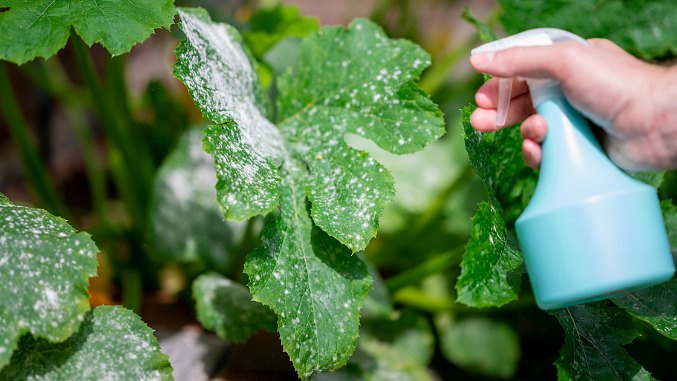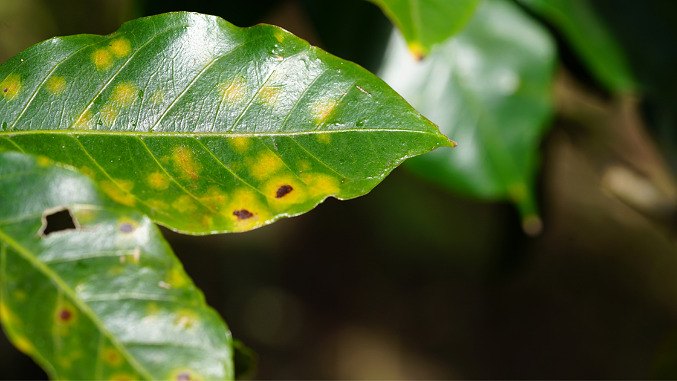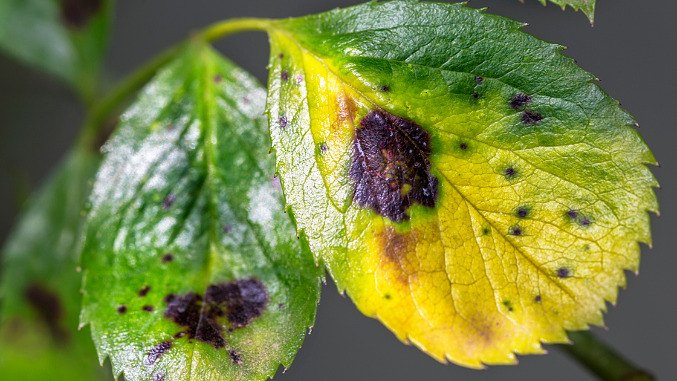
How to identify common plant diseases
5 Minute Read
In this article, we'll explore key visual cues, unusual growth patterns, and discolouration that can help you diagnose and address plant diseases, preserving the health and vitality of your plants and garden.How to spot and treat common plant diseases
As gardeners, we take pleasure in watching our plants grow and thrive. However, our plants can suffer from various diseases that can compromise their health if not identified and treated in time. By learning to recognise common plant diseases, we can arm ourselves with the tools and knowledge to nip these problems in the bud to keep our plants happy and healthy!Powdery mildew
What is powdery mildew?
Powdery Mildew is a one of the most widespread and easily identifiable plant diseases. It appears as a white, powdery growths on leaves and stems, which can sometimes affect flowers and fruits. It rarely will kill the plant but will heavily impact their vigour and impacts their visual attractiveness.
Powdery mildew isn’t a single pathogen, rather it is a name given to many different, but related, fungal species – each of which can only infect their target plant.
Powdery Mildew is a one of the most widespread and easily identifiable plant diseases. It appears as a white, powdery growths on leaves and stems, which can sometimes affect flowers and fruits. It rarely will kill the plant but will heavily impact their vigour and impacts their visual attractiveness.
Powdery mildew isn’t a single pathogen, rather it is a name given to many different, but related, fungal species – each of which can only infect their target plant.
How does it infect and spread?
To colonise a plant the spores require prefer warm, dry but humid conditions - they don’t enjoy free water on the leaf – to germinate. This makes it particularly prevalent during the summer. In these conditions, the spores will colonise the leaf and begin to grow into the characteristic powdery masses, to then release more spores that are spread via wind during the growing season.
Spores can also come from dead plant material, meaning they can overwinter on leaves that have been dropped in the previous year – which allows them to reinfect new growth in spring.
Spores can also come from dead plant material, meaning they can overwinter on leaves that have been dropped in the previous year – which allows them to reinfect new growth in spring.
Can powdery mildew impact every plant?
The good news with powdery mildew is that each fungal species is only able to target specific plants - for example powdery mildew on Hydrangea won’t impact Cosmos and vice-versa - so some varieties don’t have powdery mildew pathogens.
This is also good news as one infected plant won’t cause an infection in all of the different plants across the whole garden. However, infected plants suggest that the conditions are well suited to powdery mildew infection occurring and so you are at risk of your other plants being infected if the spores for their specific powdery mildew fungus arrives.
The good news with powdery mildew is that each fungal species is only able to target specific plants - for example powdery mildew on Hydrangea won’t impact Cosmos and vice-versa - so some varieties don’t have powdery mildew pathogens.
This is also good news as one infected plant won’t cause an infection in all of the different plants across the whole garden. However, infected plants suggest that the conditions are well suited to powdery mildew infection occurring and so you are at risk of your other plants being infected if the spores for their specific powdery mildew fungus arrives.

How to control powdery mildew
Prevention method:• Remove infected leaves, plant material, or infected plants – both live material on the plant during the summer and dead material on the ground over winter.
• Overhead watering will create leaf moisture that limits spore germination.
• Good spacing between plants and keep them far enough away from walls and fences to ensure good air circulation and limit humidity.
• Limiting nutrition and water inputs will limit soft growth that is more susceptible to powdery mildew infection.
Treatment method:
• Apply SB Plant Invigorator, an organic plant protection solution that is suitable for use on edible and ornamental plants.
• Spray onto infected plants, making sure that plant is well covered with a fine spray. Treatment needs to make contact with the powdery mildew to give effective control.
• Do not use at higher concentrations as this could scorch the plants.
• Apply SB Plant Invigorator, an organic plant protection solution that is suitable for use on edible and ornamental plants.
• Spray onto infected plants, making sure that plant is well covered with a fine spray. Treatment needs to make contact with the powdery mildew to give effective control.
• Do not use at higher concentrations as this could scorch the plants.
• Before trying this method, apply a small amount on a few leaves to ensure that the plant is not too sensitive to the product – if it is, reduce the concentrations and test until no impact is observed.

Rust
What is rust?Rust is another fungal disease that appears as orange, yellow, or brown pustules on the surface of leaves and stems that can cause significant leaf drop and weaken the plant. Rust thrives in wet conditions, so proper watering techniques and managing humidity are essential in preventing its spread.
How to tackle rust:
To tackle rust, promptly remove and dispose of affected leaves, and avoid crowded planting to improve air circulation.

Leaf Spot
What is leaf spot?Leaf spot diseases caused by various fungi and bacteria result in discoloured spots on plant leaves. These spots may range in colour from yellow, brown, or black and can sometimes look greasy. They can merge and become necrotic, leading to the eventual death of plants.
How to tackle leaf spot:
To prevent leaf spot, maintain a clean growing environment by removing any affected leaves and keep the area free of debris. Water plants early in the morning to avoid moisture on the leaves overnight. Neem oil can be effective in controlling bacterial and fungal leaf spots.

Root Rot
What is root rot?Caused by overwatering, root rot leads to a favourable environment for fungi to thrive. This disease affects the root system, and symptoms include yellowing and wilting of leaves, stunted growth, and eventual death. Diagnosing root rot can be challenging, as the damage is below the soil surface.
How to tackle root rot:
To prevent root rot, ensure plants have proper drainage and do not overwater. For potted plants, use well-draining soil mixes and pots with drainage holes. If you suspect root rot, gently remove the plant from the soil and trim off any affected roots. Replant in fresh, well-draining compost and follow a watering schedule to avoid overwatering.

Wilt
What is wilt?Several pathogens, including bacteria, fungi, and viruses, can cause wilt in plants. Infected plants may start showing symptoms like yellowing and wilting of leaves, sometimes followed by leaf drop. In some cases, plants may show wilting despite having adequate soil moisture, indicating the presence of a disease.
How to tackle wilt:
To tackle the issue of wilt, remove and dispose of any infected materials. Keep your garden free of weeds and debris that may harbour pathogens, use disease-resistant plant varieties and ensure proper soil drainage.

Being aware of common plant diseases and finding out how to prevent them will help to keep your plants happy and healthy for longer. If you are unsure if your plants have any of these mentioned diseases, please refer to our Plant Diagnosis Centre for more information.
For further advice on managing plant diseases, please contact our team via help@fargrohomeandgarden.co.uk and we'll do what we can to help.
For further advice on managing plant diseases, please contact our team via help@fargrohomeandgarden.co.uk and we'll do what we can to help.
Related articles

Plant diagnosis centre
Here you'll find remedies and solutions to numerous common problems that can affect your plants. Whether it's pests, disease or fungus, indoors, outdoors or in the greenhouse, we've got you covered.find out more

The Definitive Guide to Garden Pests
With Dr. Ian Bedford. Every month Ian will share information on his 'bug of the month', how to protect your plants and gardens from preventable pest invasions and provide valuable insights into the insects regularly found in our gardens.find out more
Tags: Plant protection equipment, Soil health
Comments (0)
Why not be the first to send us your thoughts?
